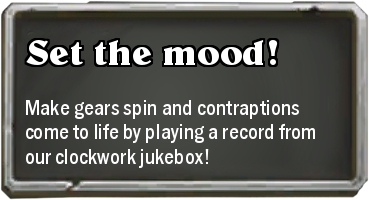Clockwork
In Himinil, science is a popular subject. Though, not many actually view the sciences as, well, science. Mostly as something that just works. For those who have an eye for curiosity, engineering is a popular profession. An engineer is more akin to a scientist than to someone who simply builds things. They experiment and tweak their various creations, always finding a way to optimize them with a feverish obsession. What engineers do in the day to day is craft various types of clockwork machinery. These are primarily made of copper, brass, and bronze which are some of the most common metals to find. These machines are used for a multitude of purposes, ranging from household chores to transportation. Though most folks cannot afford clockwork, some machines are passed down the generations. The typical household has one or two clockwork machines.
A piece of clockwork needs to be wound in order to perform its task. Each one has a specific task. Such as doing dishes, sewing a shirt, or cooking a specific meal. More complicated machines have various keys that, when turned in certain orders, change the machines function. Of course, some machines are too complicated or large to turn by hand. So windmills are used to turn larger machines and Warp Pearls are used in the more expensive pieces of machinery. These pearls allow a piece of clockwork to turn indefinitely, but with a risk. Sometimes, clockwork powered by Warp Pearls become altered.
Less than a decade ago a clever engineer discovered a way to create complex functions for machines using intricate small gears integrated with Warp Pearls. These machines are complicated enough to keep a humanoid form, register events around it, and act according to certain parameters. These Automatons are used as soldiers, butlers, pets, or workers. There is a risk, occasionally they go wild. The warp stones can change the Automatons purpose. Worker Automatons sometimes stop doing what they were programmed for and build completely different buildings.
Power Source
Clockwork needs a power source in order to function. In Himinil, there are four common sources of power used in clockwork. Wind energy is the most common. Almost every island with people on it has at least a few windmills. Because wind is unreliable, it is not used for necessary objects. Water mills are another source of power. These are stronger and more reliable than windmills, but they must have a source of water. Smaller clockwork devices are powered by hand. They use a key, sometimes unique to the device, to wind gears. The most useful source of power is the Warp Pearls. These pearls constantly twist and turn. Engineers discovered that these Pearls can be clamped to a special device, called a Pearl Stabiliser, they spin rather quickly. Warp Pearls are weaker than wind and water mills but are far more reliable. Pearls never stop spinning. This form of free energy is quite sought after throughout the world, and thus became the standard for wealth. A Warp Pearl has the approximate strength of a full grown man and can power a lot more than one would think based on its size. An Automaton only needs one to continue to work without rest. An entire airship can travel around the world powered by one warp pearl, but most use three to five. The most mystical of the Warp Pearls properties is their ability to change the world around them. When implemented into a machine, the machine changes. More experienced engineers claim that each pearl has its own personality and the more eccentric engineers claim the pearls become the heart of a new living creature. The pearl often reinforces the machine. A machine with a warp pearl might have five or six gears in the morning, but after a short time, it will have dozens of smaller gears with a few failsafe mechanisms built in. There is no rhyme or reason to these changes. However, every machine changes in some way if a pearl is added. This may not always be noticeable, however.Common Devices
Clockwork Spider
A tool made famous by the Spiders of Meuclont. These are simple tools as far as clockwork goes. They resemble a small orb with eight metallic legs with a key to wind them. When wound, the spider walks in a straight line for one foot for every turn of the key. When the spider reaches the end of its distance it explodes. The explosion is not large enough to cause massive destruction, but it can kill a man if the spider is on their person. The main use of a Clockwork Spider is to disable machines from a distance or cause a distraction. Variations on the design are common. Larger spiders, spiders that can walk over terrain, aquatic spiders, and faster spiders are a few examples.Timed Disabler
This tool appears to be a disk about the size of a fist. This disk is magnetic and can be attached to a gear. After being wound, the tool will remain in dormant for an amount of time equal to the time being wound, up to three hours for most. After this set of time, a small steel bar juts from the bottom of this tool. This steel bar is designed to jam moving gears. This tool is designed to sabotage and damage clockwork machines while giving the saboteur time to get away.Fishenden Wings
An invention of Demetrius Hamilton Fishenden as an effort to make sailing safer, this clockwork device looks like a small backpack with a set of propellers on the bottom. This pack straps to the chest and weighs around 50 pounds. When a small cord is pulled on the chest, large paper wings extend from the center pack and the propellers spin quickly. This allows the wearer to essentially fly for a few seconds before the wings fall apart. This is just enough time for someone to fly back to an airship they just fell from. This makes the tool incredibly common for sailors but is also a common tool for assassins who need to make a quick getaway. Especially adventurous and confident pirates will use these wings to board airships quickly.Clockwork Jewlery
As a sign of grace and beauty, many nobles and other rich people wear jewelry crafted from fine clockwork mechanisms. This pieces of jewelry are intricate and move subtly. Bird earrings which flap their wings gently and appear to fly, an amulet which displays the four seasons in motion, and headpieces that have small dancing figures are a few examples. These jewelry are very risky to wear, as getting cloth or hair caught in this jewelry is considered extremely inelegant.Clocks
Clocks are very common in Himinil. Every starting engineer starts their career by creating clocks. Simple or broken clocks are cheap and easy to find. Pocket watches are treated as a piece of jewelry. The more intricate the more expensive and impressive. Most clocks follow the standard time. However, there are many clocks that are set to a unique time for various organizations. Secret societies, thieves guilds, and cultists create and distribute unique clocks that may not follow the standard 24 hour time. The reason for this is to act as a password that changes every moment. Someone knocks on a plain door in an ally, and a voice from within says "What time is it?" If you have the right timepiece, then you are allowed entrance to whatever happens behind closed doors. More expensive clocks house warp pearls to keep them wound. These clockwork devices are reliable for a while, but occasionally these clocks change. Instead of keeping time, they might start ticking away with the wearer's life, when the clock reaches 0, the wearer dies. Another example would be a clock which chimes thirteen times on the thirteenth hour, giving the people around the clock an extra hour in the day. Sentient clocks are a possibility as well. Keeping time until they have the opportunity to play a prank on their owner. Rumor speaks of a clock that runs backward in time that is gained when it is lost and lost when it is found.Clockwork Prothsetics
A very clever Gnome called Shalne discovered a strange phenomenon. When clockwork and a warp pearl are integrated into a living being, there is a chance that it will "meld" into the creature. One must be careful to not actually place the warp pearl in the flesh, doing so may cause death or the creation of a warlock. However, a warp pearl surrounded by clockwork will not cause this effect. The process is quite expensive, but not so expensive that a common sailor could not afford at least one in their lifetime. Limbs are the most common form of Clockwork Prosthetics, but three times a clockwork heart transplant was successful. Oftentimes those who lost their limbs will use this opportunity to add tools to their prosthetic. Lock picks, pipes, wrenches, and knives are a few examples, but there are many possibilities.Coolant injector
With mechanical action comes workload and with it - heat. In order to keep clockwork from overheating, engineers incorporate access points into their inventions through which they can inject cooling liquid, should the need arise. Very often a device will be wound up, do it's job and the rest, but more complicated contraptions may work for a longer amount of time and be constantly needed. They have to be operated and maintained by on-duty engineers who are in charge of inserting coolant into the system, making sure it doesn't malfunction and repairing it when it does. This becomes especially critical for the various automatons, which almost never shut down. While static contraptions are maintained by other people and are sometimes linked directly to a cooling system, automatons are constantly on the move and cannot always be allowed the luxury of being followed by a dedicated engineer. Mainly for this reason, coolant injectors were invented - a portable and flexible in it's use one-time supply of cooling liquid at the ready, should the need arise.Pearl Engine
Perhaps one of the most important clockwork machines. This device is simple in concept. It is simply a box which contains a warp pearl that continuously spins a cog. This cog can be replaced by others to adapt to different sizes, shapes, and function. This machine supplies infinite energy, but slowly. The main advantage of this machine is it can wind gears and machines by itself. More complex versions of this machine have been made. Some that have a set timer, so it only winds a machine for a set time. Others allow for multiple pearls, up to five, to speed it up. Almost every ship contains one of these machines, so they may not lose power while traveling.Power Spring
Power Springs are small cylindrical devices which are used to store energy. They do this in the form of springs which are designed in such a way to keep the tension ready for release. These are used to quickly spin something, such as a propeller, or to act as a battery of sorts for clockwork devices. These are commonly wound by Pearl Engines.Automatons
Automatons are the most complex and expensive machines. They are so complex, that they can register the world around them in a rudimentary way. Glass eyes with a deep red glow allow Automatons to see basic shapes and recognize them as moving or not moving. This is the most basic form of their sense, and more complex machines can hear and see more. They can use this information to perform various tasks such as repair objects, target enemies, or mine. In any generic company, there is one automaton per 100 workers. They are used for dangerous and difficult work, such as moving hot objects, mining straight downwards, or fixing objects over a sheer drop. One is every 100 automatons change their function by themselves. This is an effect of the warp pearls. Some of these automatons become raging killing machines known as Rippers, while others gain full intelligence and memories. Rippers are extremely dangerous and are one of the main targets of inquisitors.History
The Gnomes undisputably invented clockwork. The specific gnome who invented the technology is unknown, but legend says that he did it by studying a rare breed of grasshopper which used a large gear-like growth to launch themselves forward. The earliest Clockwork devices were made of wood as a form of artistic amusement, but the clever Gnomes soon discovered other uses for it. They experimented with different materials as well. Clay was too brittle, stone was too cumbersome and would chip easily, wood did not last. However, when the Gnomes discovered metal they had the perfect material to work with. True, it was sometimes more difficult to craft than other materials, but the durability of the first metals allowed for more clockwork devices. The toys and contraptions in Gnome society sparked the imagination of their young scholars. Soon, they crafted the airship and set off to spread their knowledge. When Clockwork was introduced to humans, it was seen as an alien, almost science fiction device. But, over the years human craftsman was able to unlock its secrets with the help of the Gnomes. The first human clockwork craftsman would keep a dozen or so apprentices that would produce the pieces of clockwork technology. The Craftsman job was to put the device together. After nearly a century of this technology being crafted in this manner, the next stage of clockwork technology began to emerge. Several companies were being created with the sole purpose to produce and distribute a single clockwork part. This allowed anyone with an idea to get a hold of clockwork parts. They were sold as hobbyist supplies as well as professional grade product. It became very profitable to sell the parts, the smaller the better. So, as metals and tools allowed it craftsman would learn to create smaller and smaller parts. Pocket watches, handheld toys, and many other handheld devices like this were now possible to be made en mass. This was around the time that Warp Pearls were being used to power the machines. They were used in larger machines mostly, but a few handheld devices used them as well. This era of Clockwork lasted 160 years before a young engineer had a brilliant idea. He crafted a massive clockwork device that fits inside a building. This device, when powered by a combination of warp pearls and a watermill, would create a single gear of a standard size. Before this, gears and other parts were not standardized, they were designed uniquely for each piece of clockwork. This machine produced a few dozen gears every 2 hours, which was much faster than any person could make even one. Craftsmen would start to use these standardized sizes and shapes. This trend exploded across the world, allowing the crafting of clockwork to be much easier and much cheaper. When the Great War occurred, the use of clockwork in warfare was heavily expanded on. This forced the world to quickly enhance and expand upon clockwork technology. Now, clockwork is being used in almost anything that can be automated. However, most governments restrict those who can craft clockwork. Criminals and the clinically insane are not allowed to sell their creations for instance. However, this does not stop underground crafters to create their devilish inventions. Clockwork Craftsman, or Engineers, are well paid for their talent and many grow up with the dream to become an engineer. The craft is very competitive and difficult, however, so it is unlikely that they will break through to the industry.Remove these ads. Join the Worldbuilders Guild





Amazing work James
World Anvil Founder & Chief Grease Monkey
Twitter | World Anvil Changelog
“No act of kindness, no matter how small, is ever wasted.” - Aesop